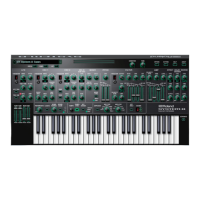10
Editing the Sounds
Editing a Patch
1. Press the MODE [PATCH] button.
The SYSTEM-8 is in patch mode.
2. Select a patch as necessary (p. 9).
3. Move the top panel knobs and sliders.
When you operate a knob or slider, the parameter name, and value
appear. After a few seconds, the top screen reappears.
OSC 1:
Waveform SAW
&
For details on the parameters, refer to “Reference Manual”
(PDF).
When you edit a patch, an “*” appears at the left of the Bank–
Number.
PATCH SYS8 *A-1
User_Patch_Name
MEMO
In addition to panel operations, MENU: PATCH EDIT also
contains editing items (bender settings, patch name, etc.).
Editing a Performance
1. Press the MODE [PERFORMANCE] button.
The SYSTEM-8 is in performance mode.
2. Select a performance as necessary (p. 9).
3. Press the [MENU] button.
The MENU screen appears.
Making settings for the entire performance
4. Use the Cursor [
K
] [
J
] buttons to select “PERFORM
EDIT,” and then press the [ENTER] button.
<MENU> [Ent]
ÄPERFORM EDIT À
* “PERFORM EDIT” is not shown in patch mode.
5. Use the cursor [
K
] [
J
] buttons to select a parameter,
and use the [VALUE] knob to edit the value.
PERFORM:COMMON
Perf Mode DUAL
Parameter
Value
&
For details on the parameters, refer to “Reference Manual”
(PDF).
6. Press the [EXIT] button to return to the MENU
screen.
About the PERFORM EDIT: COMMON: PERFORM MODE
parameter
With the “Dual” mode setting, you can perform using both the
upper part and the lower part. The maximum polyphony of each
part is four notes.
With the “Single” mode setting, you can perform using either the
upper part or the lower part, not both. The part on which you
perform has a maximum polyphony of eight notes.
In this case, use the PANEL ON/OFF [UPPER] [LOWER] buttons to
select the part that you want to edit.
Making settings for each part
7. Use the Cursor [
K
] [
J
] buttons to select “PART EDIT,”
and then press the [ENTER] button.
<MENU> [Ent]
ÄPART EDIT À
* “PART EDIT” is not shown in patch mode.
8. Use the cursor [
K
] [
J
] buttons to select a parameter,
and use the [VALUE] knob to edit the value.
Sound selection screens for the upper part and lower part
UPPER mmmm b-n
User_Patch_Name
mmmm: Model button
b-n: Bank–Number
Patch name
LOWER mmmm b-n
User_Patch_Name
MEMO
Use the PANEL SELECT [LOWER] [UPPER] buttons to select the
part whose sound you want to edit.
Examples of other editing screens
PART:COMMON [U]
Level 0.0dB
PART:PITCH [L]
Octave -1
MEMO
Use the PANEL SELECT [LOWER] [UPPER] buttons to select the
part whose sound you want to edit.
&
For details on the parameters, refer to “Reference Manual”
(PDF).
9. Press the [EXIT] button several times to return to the
top screen.
MEMO
You can use the PART EDIT: COMMON: PART KEY RANGE
LOWER/UPPER parameters to specify the key ranges (bottom
and top keys) of the upper and lower parts.

